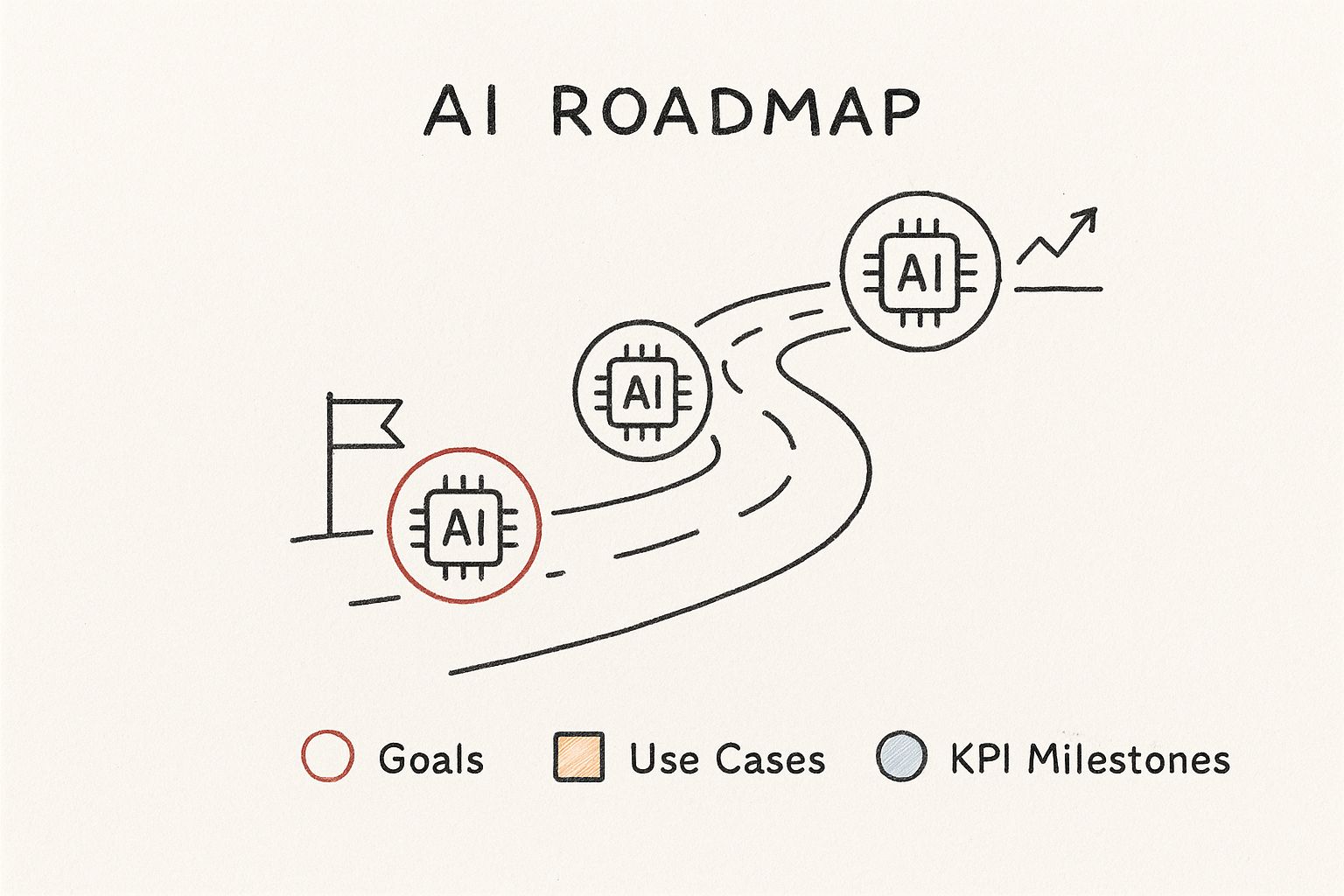Your AI Implementation Strategy Playbook
Build a winning AI implementation strategy with this actionable guide. Learn to align AI with business goals, prioritize projects, and drive real growth.

An AI implementation strategy is essentially a business plan for how you’ll use artificial intelligence. It's the blueprint that connects your AI initiatives directly to what the company is trying to achieve—whether that's growing revenue, improving customer service, or making operations more efficient. It’s what separates a real business driver from a series of cool-but-disconnected tech experiments.
This plan gives you a structured roadmap for choosing the right AI projects, developing them thoughtfully, and scaling them across the organization. The goal is to avoid wasting time and money on ideas that go nowhere.
Why a Plan Beats an Ad-Hoc Approach to AI
It’s tempting to jump straight into AI. We see it all the time: a team gets excited about a new tool and starts a project without thinking through the bigger picture. But this reactive, ad-hoc approach is one of the most common reasons AI initiatives fail. It leads to disconnected projects that sound impressive in a meeting but deliver zero tangible business value.
A formal AI implementation strategy is your guardrail against that. It forces you to be deliberate, ensuring every dollar and every hour you invest actually pushes you closer to your most important goals. As we explored in our AI adoption guide, this structured approach is what prevents those costly, isolated experiments that so often sink promising AI work.
Let’s be clear: AI isn't just a side project for the IT department anymore. It’s a core business function. To get it right, you need a plan that considers the technology, the people who will use it, and the processes it will change. From our experience with AI co creation, the companies getting the best returns are the ones that treat AI as a strategic asset from day one. They build the plan first, then they execute.
The Growing Imperative for a Strategy
The speed at which AI is weaving itself into the global economy makes a strategic approach non-negotiable. The global AI market is on track to hit a staggering $1.81 trillion by 2030, which is nearly a fivefold jump from 2025.
Right now, about 73% of organizations are already using or at least piloting AI. If your approach is purely reactive and unplanned, you’re not just experimenting—you’re actively falling behind. You can find more details on these global AI market trends on ff.co.
A lack of strategy is the number one cause of "pilot purgatory," where promising AI projects get stuck in the testing phase and never see the light of day. A clear plan gives you the framework to push a successful proof-of-concept into a full-scale deployment that actually generates value.
Sure, an ad-hoc approach might get you a few isolated wins, but it rarely builds any real, sustainable momentum. Without a guiding strategy, your teams will constantly struggle to prioritize projects, you’ll have a hard time securing consistent funding, and measuring the true ROI will be next to impossible.
This is where a formal AI strategy consulting process makes all the difference. It turns AI from a series of disjointed tech projects into a powerful, cohesive engine for business growth. The difference in the outcomes between a planned and an unplanned approach is stark.
Strategic vs Ad-Hoc AI Implementation Outcomes
The table below really drives home the point. It contrasts the typical business outcomes for companies that invest in a formal AI strategy versus those taking a more unstructured, reactive approach.
| Metric | Strategic AI Implementation | Ad-Hoc AI Implementation |
|---|---|---|
| Project Success Rate | Significantly higher, with clear goals and KPIs from the start. | Lower, with many projects failing to scale or show value. |
| Return on Investment (ROI) | Measurable and aligned with business objectives. | Difficult to calculate; often results in wasted budget. |
| Resource Allocation | Focused on high-impact, feasible projects. | Scattered across multiple, often disconnected, initiatives. |
| Scalability | Designed for enterprise-wide deployment and growth. | Pilots often stall and are difficult to integrate broadly. |
| Business Alignment | Tightly integrated with core strategic priorities. | Loosely connected to business goals, if at all. |
As you can see, the choice isn't just about process—it's about results. A strategic approach is designed for success, scalability, and real business impact. An ad-hoc approach, on the other hand, is a recipe for frustration and wasted potential.
Setting the Foundation for AI Success
Before you even think about deploying a single algorithm, you have to lay the groundwork. I’ve seen it time and again: the success of any AI implementation strategy has less to do with the cool tech and more to do with the unglamorous, non-technical prep work done upfront. This is where you ground your ambition in reality, making sure you’re building on rock, not sand.

First things first, you have to tie every potential AI project back to a real business goal. What are you actually trying to achieve? Are you looking to cut operational costs by 30%? Or maybe you're aiming to completely overhaul the customer experience to boost loyalty. Without a clear "why," even the most powerful AI tool is just an expensive hammer looking for a nail. This is exactly where a strong strategy, sometimes guided by expert consulting, can help you turn vague objectives into concrete AI initiatives.
Conducting an Honest Readiness Check
With your goals in focus, it's time for some real talk—an honest internal readiness check. You need to take a hard look at three critical areas inside your organization.
- Data Infrastructure: Is your data actually usable? Is it clean, accessible, and relevant? AI models are hungry for good data, and if you feed them garbage, you'll get garbage out. Data readiness isn't just a nice-to-have; it's a deal-breaker.
- Team Skills: Do you have the right people on the bus? You need to know where your skill gaps are, whether that's in data science, machine learning engineering, or even AI ethics.
- Company Culture: Is your organization truly ready for this shift? If your culture is allergic to data-driven decisions or is spooked by automation, you're setting yourself up for a quiet failure.
Getting this right often means looking at the bigger picture of the future of work with human and AI collaboration, which shows how this is about partnership, not replacement. You’ll likely need a mix of upskilling programs for your current team and some strategic hires to bring in the specialized expertise you're missing.
Securing Buy-In and Establishing Governance
Now for what might be the most crucial piece of the puzzle: getting genuine buy-in from leadership. This isn't just about getting a budget approved. It’s about making sure your executives truly understand the strategic value and are ready to champion the cause when things get tough. A great way to solidify this is by creating a cross-functional AI governance team.
This team should have a seat at the table for people from IT, legal, operations, and the key business units. Their job is to steer the ship—setting ethical guardrails, managing risk, and making sure every project stays locked on to the company's core strategy.
This approach stops AI from becoming just another siloed IT project and weaves it into the organization's DNA. A clear governance structure is a core part of any AI strategy framework, giving you the stability needed for the long haul. Once you have these foundational pillars firmly in place, you can start moving from planning to execution with confidence.
How to Find and Prioritize Winning AI Projects
Okay, you've laid the groundwork. Now comes the part that can make or break your entire AI implementation strategy: choosing where to start. The goal isn't just to find any AI project; it's about moving from big ideas to tangible applications that actually deliver value.
This is where a lot of companies stumble. They either get too ambitious, pouring resources into a massive, complex project that never gets off the ground, or they play it too safe with a tiny project that no one cares about. The real win is finding that sweet spot—a project that delivers a noticeable return without being a nightmare to build.
Brainstorming and Scoring Potential Projects
First things first, get the right people in a room. I’m talking about a mix of folks from sales, marketing, operations, IT, and customer service. Run a brainstorming session focused on real pain points and opportunities. What are the biggest bottlenecks? Where are people wasting hours on repetitive, mind-numbing tasks? What could you do for your customers that feels impossible today?
Let the ideas flow. At this stage, nothing is off the table.
Once you have a long list, it's time to bring some structure to the chaos. You need a simple, consistent way to rank these ideas. I've found a scoring matrix works best, evaluating each potential project against a few key criteria:
- Business Impact: Will this actually move the needle on revenue, cut significant costs, or make our customers happier?
- Technical Feasibility: Do we have the data, the tech stack, and the skills to realistically build this? Or are we dreaming?
- Strategic Fit: How well does this project line up with our bigger company goals for the next one to three years?
This visual guide can help you map out how these initial projects fit into your broader AI journey, connecting early wins to long-term strategic goals.

The roadmap really puts it into perspective: selecting the right use cases now is the foundation for hitting your most important KPIs down the road. To get this crucial first step right, our AI requirements analysis tool can help you nail down the specific scope and needs for each project, making your scoring process much more accurate.
AI Use Case Prioritization Matrix
To make this process more concrete, we use a simple scoring model. It helps turn subjective opinions into a more objective priority list, making it clear where to focus your energy first.
| Use Case Example | Business Impact (1-10) | Technical Feasibility (1-10) | Implementation Cost (Low/Med/High) | Priority Score |
|---|---|---|---|---|
| Predictive Lead Scoring | 8 | 9 | Medium | 17 |
| Automated Invoice Processing | 6 | 10 | Low | 16 |
| AI-Powered Product Recommendations | 9 | 7 | High | 16 |
| Customer Service Chatbot | 7 | 8 | Medium | 15 |
| Supply Chain Demand Forecasting | 10 | 4 | High | 14 |
Note: The Priority Score is calculated by adding Business Impact and Technical Feasibility. Cost is considered as a secondary factor for tie-breaking or resource planning.
This kind of matrix immediately highlights the low-hanging fruit—the projects with high scores that won't drain your budget. These are your "quick wins."
The best place to start is with a "quick win"—a project that scores high on both business impact and feasibility. This approach builds momentum, shows the value of AI to the skeptics in the room, and earns you the political capital you'll need for bigger, more ambitious projects later on.
For instance, automating invoice processing might only have a moderate business impact (a 6), but if its feasibility is nearly perfect (a 10), it becomes an excellent starting point. On the flip side, creating a fully autonomous supply chain could have a massive impact (a 10), but if the current feasibility is low (a 4), it’s a project for the future, not for today.
If you're looking for more ideas, checking out some real-world use cases is a great way to see what others in your industry are successfully implementing.
Weaving Your AI Roadmap Into Reality
You've pinpointed your high-priority AI projects. Fantastic. But a list of ideas isn't a plan. The next crucial step is to weave those individual initiatives into a coherent, actionable roadmap. Think of it less like a rigid project plan and more like a strategic guide that builds momentum, manages risk, and maximizes learning with each step.
A fantastic way to get started is with a small-scale pilot project. This isn't about boiling the ocean; it's about proving the concept in a controlled, low-risk environment. A successful pilot becomes your best internal marketing tool, a tangible proof point that makes it infinitely easier to get the resources and executive buy-in you'll need for the bigger, more ambitious phases down the line.
To Build or To Buy? That is the Question.
One of the first major forks in the road you'll encounter is whether to build a custom AI solution from scratch or buy an existing platform. There’s no universal right answer here. The best choice really hinges on your specific needs, your team's capabilities, and your long-term strategic goals.
- Buying an off-the-shelf solution gets you to market faster and with a lower upfront investment. This is often the smartest move for common business problems where great solutions already exist—think customer service chatbots or marketing automation tools. The trade-off? Less customization and the risk of being tied to a specific vendor's ecosystem.
- Building a custom model gives you something nobody else has: a proprietary solution tailored to your unique challenges. This is the path for core business functions where a bespoke AI could become a serious competitive advantage. Just be prepared for a significant investment in specialized talent and infrastructure.
This decision has gotten a lot more interesting recently. The cost of running powerful AI models has absolutely plummeted. In fact, between November 2022 and October 2024, the cost to run models similar to GPT-3.5 dropped by a staggering 280 times. This is thanks to smaller, more efficient models and better hardware. You can dig into these AI cost and efficiency trends in the 2025 AI Index Report for the full picture.
Your roadmap needs to breathe. Treat it as a series of agile sprints, not a monolithic, multi-year plan set in stone. This lets you adapt to new tech, absorb what you learn from pilots, and pivot based on real results without derailing the whole strategy.
Once you have this roadmap in place, bringing it to life hinges on effective team project management. Every step needs to be planned and coordinated flawlessly.
Setting Milestones and Fueling the Engine
With your build-or-buy decision made, it’s time to start plotting key milestones on a timeline. Break down each project into logical phases: data prep, model training, user testing, and the final rollout.
Be realistic here. Assign achievable timelines to each phase and, most importantly, allocate the necessary budget and people. This level of clarity is non-negotiable for keeping the project on track and managing what everyone—from the dev team to the C-suite—expects to see and when.
If you're looking for a more structured approach, you can explore our own AI strategy framework. We've also developed an AI Strategy consulting tool that can help automate parts of this planning, ensuring your roadmap is both ambitious and grounded in reality from day one.
Managing Risk and Deploying AI Responsibly
A great AI rollout is built on trust, not just clever code. Once you’ve got your roadmap sketched out, your focus has to pivot to the things that can make or break the entire project: responsible, ethical, and sustainable deployment. This is the moment you move from a brilliant technical plan to a trusted business function.

It all starts with a solid governance framework. This isn't about creating more red tape or just ticking compliance boxes. It's about being proactive. You have to get ahead of data privacy concerns, wrestle with potential model bias, and make sure you’re aligned with regulations like GDPR. Think of it as building the guardrails that let your team innovate safely.
Fostering Trust Through Transparency and Control
To get people on board—from your C-suite to your customers—you need to show your work. Implement monitoring systems that are transparent and can flag issues before they become problems.
A big piece of this is creating "human-in-the-loop" processes for any high-stakes decisions. This simply means ensuring a person has the final say when the outcome really matters. It’s a practical way to prevent blind faith in automation and maintain clear accountability.
Here are a few practical steps I’ve seen work well:
- Run Bias Audits: Don't just train your model and walk away. Regularly test it with diverse datasets to find and fix any unintended biases before they affect real people.
- Embrace Explainable AI (XAI): Use tools that can shed light on how a model reached a decision. This turns the AI from a mysterious "black box" into a tool people can understand and trust.
- Have Clear Data Policies: Write down and share exactly how you're using, storing, and protecting data—both for customers and your own internal teams.
Navigating Change Management and Adoption
The last, and maybe most important, part of a responsible rollout is managing the human side of change. As we've discussed before, building internal trust is just as critical as building the technology itself. You can’t just drop a new AI tool on your team and expect them to love it.
You have to sell the why.
Responsible AI isn't some fluffy, ethical add-on; it's just smart business. The companies that are open about their process and bake in ethical governance from day one build more trust with customers and employees. That trust isn't a risk to be managed—it's a competitive advantage.
Frame the new AI tools as a way to enhance your team's skills, not replace them. Show them how it can eliminate the tedious parts of their job so they can focus on what matters. When employees see the direct benefits for themselves, you get genuine excitement and adoption, not fear and resistance.
If navigating both the technical and human side of this transition feels daunting, bringing in some outside help can make all the difference. Professional AI implementation support can provide the focused expertise to make sure your strategy doesn't just launch, but truly lands with your team.
Measuring Success and Scaling Your AI Strategy
Getting your first AI project off the ground is a huge milestone, but it's really just the starting line. The real work begins after deployment. This is where you shift from building to measuring, learning, and figuring out how to scale what works. A great AI strategy doesn't just stop once the tech is live; it evolves to make sure that initial investment pays off again and again.
The biggest mistake I see is when teams get stuck on purely technical metrics, like model accuracy. Sure, that's important, but it doesn't tell you if the AI is actually moving the needle for the business. You have to connect the dots by tracking Key Performance Indicators (KPIs) tied directly to your original goals. This is how you prove the value and build a solid business case for expanding your efforts.
Defining What Success Looks Like
To get a true sense of the impact, your metrics need to cover a few different areas. Think about what a "win" means from various angles within the company.
- Financial KPIs: Are you actually saving money or making more? Look at things like a drop in Cost Per Acquisition (CPA) or an increase in Customer Lifetime Value (CLTV) from AI-powered personalization.
- Operational KPIs: Is the team working smarter, not just harder? You could measure a reduction in the time it takes to process invoices, faster customer support ticket resolution, or more accurate inventory forecasts.
- Customer-Focused KPIs: Are your customers happier? Keep an eye on your Net Promoter Score (NPS), customer satisfaction ratings, and whether you're seeing a decrease in customer churn.
This kind of well-rounded view gives you the full story of your AI's performance. And the stakes are high—a recent survey showed 40% of CEOs believe their companies won't be viable in ten years if they don't get AI right. The risk of waiting is becoming a massive business liability. For more on this, Ropes & Gray have a great report on the strategic imperative of AI investment.
Think of your AI strategy as a living, breathing thing. The data you get back from these initial projects is what feeds its growth. Use those insights to tweak your models and sharpen your overall approach.
Once you have a successful pilot under your belt, it's time to create a repeatable playbook for scaling. Document everything—from how you prepped the data to the deployment process and how you managed the team's transition. This turns a one-off win into a core company skill, allowing you to launch successful AI projects across different departments and for new challenges.
Turning a great idea into a real, scalable advantage takes dedicated expertise. If you're ready to continue building out your AI capabilities with some seasoned guidance, connect with our expert team. We can help you turn that strategic vision into a lasting competitive edge.
Still Have Questions About Your AI Strategy?
Even with the best-laid plans, a few questions always pop up when you're getting started with AI. It’s completely normal. Let’s tackle some of the most common ones I hear from leaders who are in the exact same spot you are.
Where Do I Actually Begin?
This is the big one. It's easy to get lost in the tech, but the real starting point has nothing to do with algorithms or platforms. It’s all about the business.
Before you write a single line of code, you have to nail down the specific business problem you're trying to solve. Are we trying to shave 20% off our customer service response time? Or maybe create a brand-new personalization feature that could boost sales by 15%? Start with a clear "why" that everyone understands and agrees on. Everything else—the data, the infrastructure, the tools—flows from that.
How Do We Choose Our First AI Project?
Everyone wants to go for the moonshot right out of the gate. I get the ambition, but it's usually a recipe for disaster. The smartest move is to pick a pilot project that's both high-impact and low-effort. Think of it as a quick win.
A simple prioritization matrix can be your best friend here. Just score your potential projects on a few key criteria:
- Potential ROI: How much value will this actually deliver?
- Technical Feasibility: Can we realistically build this with our current resources?
- Data Availability: Do we have the clean, accessible data we need to make it work?
Your first project isn't just about the tech; it's about building momentum. A successful pilot proves the value of AI, gets your stakeholders excited, and teaches you invaluable lessons for the bigger, more complex initiatives you'll tackle later.
What Should Our Budget Look Like?
There's no single price tag for an AI implementation—it really depends on whether you decide to "buy" or "build."
Going with a "buy" approach, where you use off-the-shelf AI software, means lower initial costs. But you'll have to account for ongoing subscription fees. On the other hand, a "build" strategy, where you create custom models from scratch, requires a much bigger upfront investment in specialized talent and powerful infrastructure.
My advice? Don't try to budget for the entire multi-year roadmap at once. Start by defining a clear, fixed budget for your pilot project. This will give you a much more realistic picture of what things actually cost.
If you have more questions buzzing around, we've compiled a much more detailed list over on our AI implementation FAQ page.
Ready to turn those questions into a concrete plan? Ekipa's AI strategy platform is built to help you find and launch the right AI opportunities, fast. You can get a tailored AI strategy in just 24 hours at https://www.ekipa.ai.



